My Receiver Collection
19 May 2019
Introduction
1920s - 1950s
1960s
1970s
1980s
1990 - today
Introduction - 1990s to today
Another period of great change, where we see the introduction of Digital Signal Processing, I&Q mixers, and eventually fully Software Defined Radios. While some are still some conventional radios, other receivers are not conventional in any sense.
JRC NRD-93 (1991)
This receiver is without doubt one of the world's best. It has most of the features one needs, is easy to use,
has good sensitivity, low noise
and truly excellent audio. It is constructed in an Aluminium bin-shaped box with eight circuit boards standing vertically on a mother
board, and secured at the edges. There are shields between all the boards. The front panel is a conventional enamelled flat type with
silk-screened legends. All LED indicators are within a transparent anti-reflection panel. There are tilt feet under the receiver.
The layout is simple, understated and
pleasing. Compare it with some receivers of the previous decade!
The NRD-93 is a double-conversion receiver of conventional
design. Frequency coverage is from 90 kHz to 30 MHz.
There are three
individual frequency synthesis loops, offering 10 Hz frequency steps and 1 Hz BFO resolution. All oscillators are locked to an
internal 10 MHz TCXO or to an external 10 MHz source. Stability on the internal reference is excellent - the specification is
better than ± 5 x 10-7. The first IF is 70.455 MHz, the second is 455 kHz, where
several filters are fitted, 300 Hz, 1, 3 and 6 kHz, with provision for a user option. The receiver offers CW, USB, LSB, AM, FSK
and FAX modes. Stand-out features of the receiver include Passband Tuning, a Noise Blanker, an Audio Filter, and 60 memory channels,
where the mode and bandwidth are stored in addition to the frequency. The memory select and band select functions are performed by
the same 30-position switch.
The front-end of the receiver is fully tuned (electronically). The various bands are selected via relays, as are the IF filters.
The mixers are balanced JFET designs, while the RF and IF amplifiers employ dual-gate FETs.
Unusual Features:
- Passband tuning and a Noise Blanker are offered; rare features in receivers in this class.
- Digital display of the IF shift offset (offset range is about ± 40% of the selected filter
bandwidth)
- Digital display of the BFO offset (1 Hz resolution). Signals can be tuned with 1 Hz resolution.
- A very useful linear frequency display (1 MHz wide in 10 kHz steps), which along with the fast tuning UP/DOWN buttons
make changing frequency relatively painless.
- A frequency LOCK button, which locks only the main tuning (not the BFO or Passband). There's no indication that it is active, other than
the position of the switch.
- A useful dimmer which adjusts the brightness of all display elements.
- Direct key-entry of frequency is unfortunately not provided.
- There is no internal speaker, but there
are both Headphone and Speaker sockets on the front panel.
Unfortunately using the Headphone socket (perhaps for computer
monitoring or recording) switches off the speaker! While there is a 3 Ω speaker output on the accessory socket
at the back, this is inconvenient, and the front panel speaker output is intended for a 600 Ω speaker!
The receiver dimensions are 149 x 480 x 294 mm, and the weight is 10.5 kg. The receiver is intended for rack mounting.
There is an optional outer cabinet which increases the dimensions slightly. The power supply is via conventional transformer
and rectifier, followed by a low voltage switch-mode converter, and it offers
operation on AC from 100 to 230V as well as 24 V DC. Power consumption is 70 VA, or 50 W on 24 V. The DC input is reverse-polarity
protected.
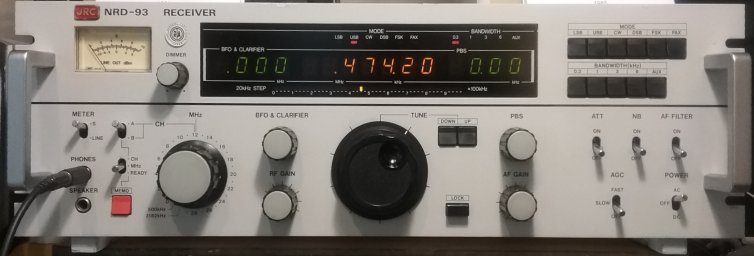
The JRC NRD-93
Drake R8A (1995)
This is one of my favourite receivers. It operates 100 kHz to 30 MHz, and like some of my other receivers, incorporates state-of-the-art design
features (for the time), such as excellent band-pass filters, passive first and second mixers, and an image rejecting (I&Q) second mixer configuration which
permits conversion directly from the 45 MHz first IF directly to 50 kHz. The second IF employs a series of LC filters to provide bandwidths of
6, 4, 2.3, 1.8 and 0.5 kHz. There is a conversion from 45 MHz to 455 kHz for FM reception. The three synthesizers and BFO are referenced to
a single 35 MHz reference crystal. The passband tuning is achieved by interpolating two synthesizers in opposite directions.
The demodulators are double-balanced, and the AM demodulator allows for a Synchronous mode, which reduces
distortion on short wave signals. The operating modes are AM, AM Sync, USB, LSB, CW, RTTY and FM.
The receiver is microprocessor controlled, and the micro has a rear-panel RS232 connection, allowing the receiver to be remote controlled.
I have written software to control the receiver and report its status in real time (see picture below).
I have had to restore the receiver, by reversing some unfortunate modifications and completely dismantling the front panel in order to clean
the panel and switches. Before I did this work, the receiver could not be controlled at all. The switches are of the type with a rubber moulding
containing a carbon rubber button, which presses on carbon ink contacts printed onto a circuit board. After cleaning and abrading the
buttons, and cleaning the ink contacts, full operation was restored. The case responded well to a clean and polish and some paint touch-up.
The covers and chassis
are sheet Aluminium, and the front panel is extruded and machined Aluminium, backed by a sub-frame supporting the display/switch circuit board.
The large and pleasing display is a back-lit LCD type, with annunciators for modes and settings, and alphanumeric display for frequency and memory names.
Frequency display resolution is 10 Hz, the same as the synthesizers, although you can choose to see fewer digits. You can also
choose to display and control the receiver in kHz or MHz.
The only really annoying features of the receiver are the sluggish and non-weighted main tuning control and the soggy feel of the
push-buttons. I have lubricated the rotary encoder and fitted a weighted tuning knob, which helped, but little can be done about
the push-buttons, which tend to mis-operate unless carefully and accurately pushed. Rubber membranes may be robust, but they are a
poor choice for a receiver where they are used all the time.
The receiver dimensions are 334 x 134 x 330 mm, and it weighs 5.9 kg. The R8 will operate from 12V DC at 2A, or from the internal
110/230V AC supply.
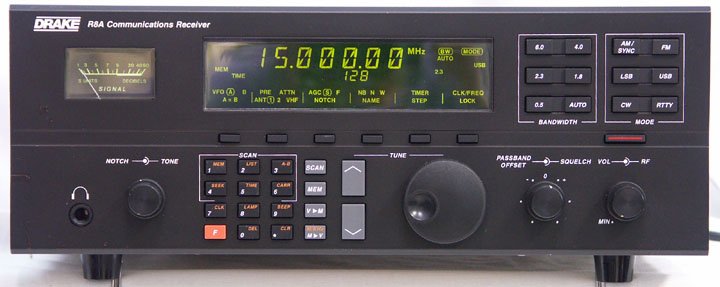
The Drake R8A receiver
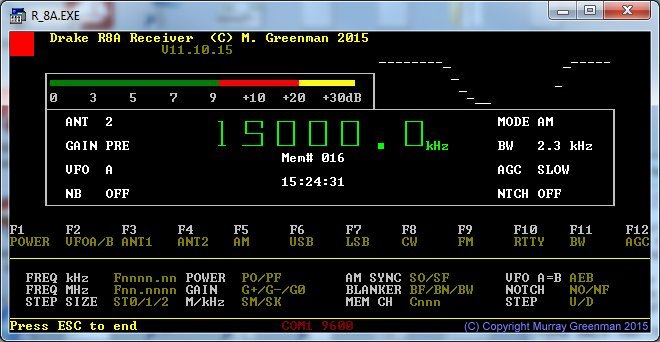
ZL1BPU remote control software operating in Win7
Sangean WR-1 Mantel Radio (~2006)
This little mantel radio has been deservedly popular. It was manufactured for many years, from about 2006, and is still available new
in some stores new for about NZ$260.
It's only an AM/FM receiver, but it is sturdy, well built, nicely finished in a lovely wooden cabinet, and has a great sound,
although Mono only.
Tuning is via a traditional back-lit analogue dial, very clear and easy to use. There is a green LED to the right, which acts as a
tuning indicator, glowing brightest when accurately tuned. The chunky 80 mm speaker is front-mounted, and there's a rear woofer
vent which enhances the bass response. There is plenty of audio. Sensitivity is reasonable, and with a decent external antenna, FM reception can't be faulted.
AM tuning is rather sharp, and while audio response seems reasonable, it's not easy to achieve
distortion-free reception without careful tuning.
At the rear are an external F-type antenna socket, an antenna switch (internal/external), REC OUT and AUX IN sockets, and a Headphone
socket. There are two power sockets, one for 230 V AC, the other for 12 V DC (9 - 14 V). Power consumption on AC is rated at 25 W.
Audio output is 7 W at 10% THD. The radio came with a separate plug-in power cord with AU/NZ plug, and a simple 1.5 metre wire antenna.
I bought this radio in 2019, from a local 'Op Shop', for just $10. It was in as-new condition, no scratches or blemishes,
apart from coffee stains on the speaker grille (visible in the oblique view below). The stains were easily removed with a damp cloth.
The wooden case is a hollow rectangular section, with the front and back clamped to it by six screws which pass from back to front,
making a very sturdy assembly. There are gaskets front and back between the panels and the case. The front panel is grey plastic,
which sits in front of the wooden case, while the rear panel is recessed grey plastic, allowing you to see the real wood at
the back. The radio tuner itself and the loudspeaker are attached to the front panel, while the power supply and audio amplifier
are attached to the rear panel. (See the 'inside' photo below).
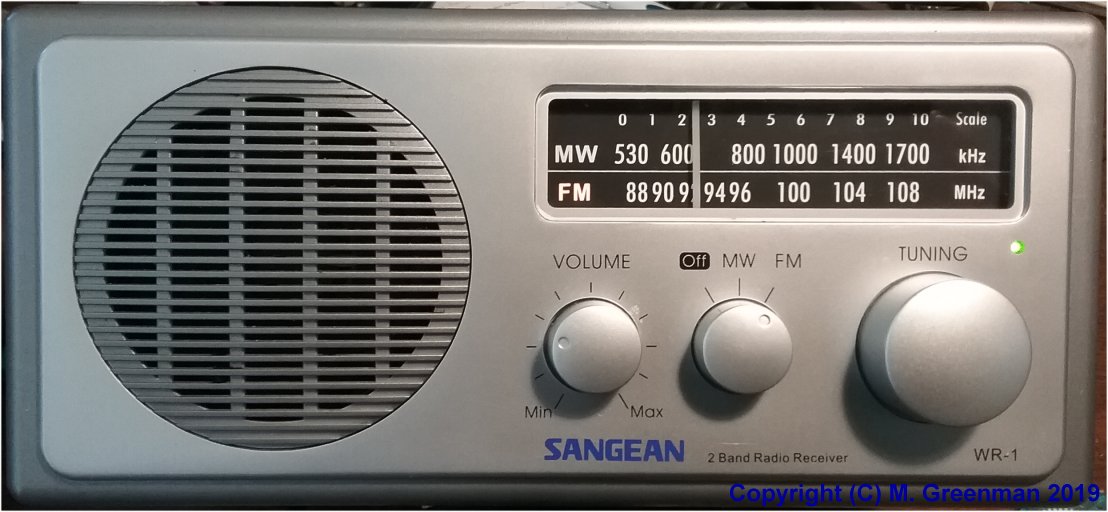
The Sangean WR-1
Jaycar YN8069 Internet Radio (~2008)
Maybe I'm stretching a point by including an Internet Radio (with no true radio reception capability) in this collection,
but it's here because it is an interesting device, and quite an early example of an Internet streaming service stand-alone receiver.
Webcasting (Internet Radio) as we know it did not evolve until broadband Internet service and compression technology such as MP3 became practical, along with sufficient processing power to operate the codecs. The first service was launched in 1993, the first streamed radio station started in 1994, and the service has now spread around the world. More people now use streaming and on-demand Internet entertainment services than traditional radio. There are
more than 20,000 stations now available.
The Jaycar YN8069 (which was available in Australia and New Zealand, and long since discontinued) is an un-badged version of the Logik Reciva IR100, available in Europe. The Scott RXi 300WL and Cobra CIR100A were other identical brands, with an original price
of around US$150, so at the budget end of the range. All were made in China, and of dubious construction quality. I was able to find the
user manual for the Scott version. On the front panel, the unit is described as an 'Internet Radio with Audio Media Streaming'.
The controller board in the YN8069 is a Reciva Barracuda, which works with an
online host to provide setup services and lists of stations. This is quite different to the modern receivers which search online
and then maintain their own station lists. The Reciva host service is still running, and I was able to register the radio and use the
setup service. Back when this was designed, micro-controllers were more limited in capability, and in addition
the limited user interface capability precluded more sophisticated control. There is no graphical display, only a mono 3-line 20-character LCD text display.
Most of the radio is built on the back of the front panel. There is a separate board carrying the push-buttons and the display,
plus a main board with the processor and wifi modem boards attached.
The power supply, audio amplifier and analog boards are mounted on the back panel. The wifi modem is a separate little
USB device which plugs into the main board.
I bought this radio at an Amateur Radio swap meet in 2019, not working. The fault was minor - a power supply problem. Connecting it
to the home network proved to be straight-forward, and although it is a little tedious to search for stations, the unit starts quickly,
remembers the last station used, and also remembers five favourite stations. The sound output is 5 W (mono) and it will drive stereo headphones (15 mW). The unit operates from 230 V AC, and consumes 20 W.
The display shows the selected service and data rate. If the streaming service includes metadata, any track and album data
is also displayed, scrolled on the third line of the display.
The case is black laquered medium density fibre-board, with moulded plastic front and back panels sandwiched to it.
Dimensions are 250 x 130 x 140 mm. The two panels are screwed together to clamp the case. The front has a sturdy clear polycarbonate overlay. The overall effect is of a shiny black device.
There is a Selector knob (rotary encoder) with push-button, a Volume control, and nine unnecessarily small push-buttons. The speaker is on the front.
At the rear is the power cord and a stereo headphone socket. The method of assembly is very similar to the Sangean WR-1 above,
but without its superior construction quality.
In addition to repairing the unit, I have also modified the wifi modem mounting position, using a short USB extension cable to
relocate the wifi modem to the inside bottom of the case, away from the micro-controller. This has significantly improved the wifi range,
and it will now operate reliably without dropping out, even at the other end of the house from the wifi hub.
Sound is excellent, with great clarity, no hum or noise, and just adequate volume. There is a tendency to bass boominess on some
music, and sometimes a buzz from the cabinet when played loud. This may be because one of the case screws can no longer be secured.
Sound from the stereo headphone socket cannot be faulted - stunning sound, and excellent separation.
One feature of the radio, which is unusual, even in today's wifi radios, is the ability to stream easily from Windows shares or UPnP servers
on the home network. This works both with appropriately configured PCs (Media Player) and Samba network file servers. It scans the
server source and builds a play list, which it stores on the server. While the idea works,
selecting the music to play is not straightforward. The scanned files can be browsed by Album, Artist and Playlist.
It will play shuffled tracks but only one album at a time.
In this mode, pause, stop and track select buttons become functional.
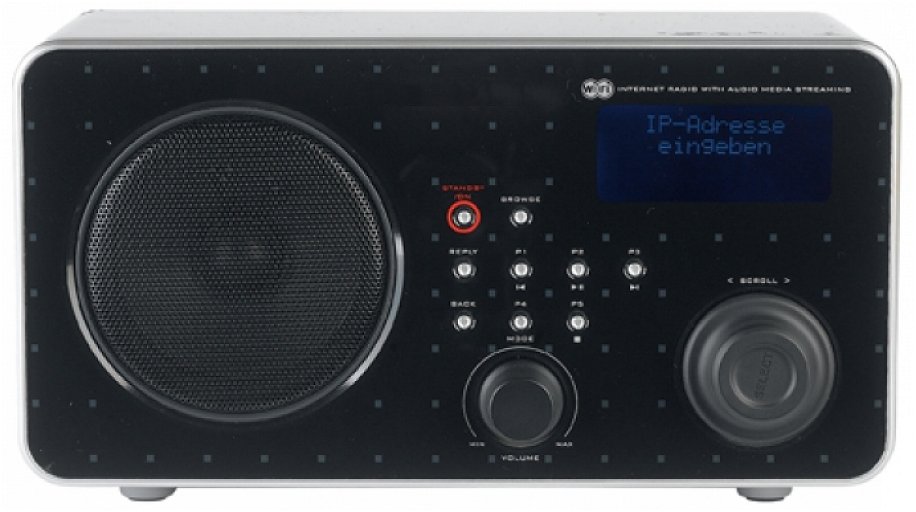
The Jaycar YN8069 Internet Radio
Signal Hound USB-SA44 Spectrum Analyser (2010)
So why is a spectrum analyser part of my receiver collection? Well, because it also makes an excellent wideband receiver!
With the software it came with, there is a receiver mode with limited capability, but the manufacturers recently released
driver software to operate with HDSDR, a popular Software Defined Radio program.
It is an odd fact that this 'receiver' predates all my modern SDR receivers, yet wasn't considered a serious receiver until
recently, with the release of the driver. The SA44 covers 1 Hz to 4.4 GHz, has a huge dynamic range, a 1ppm TCXO reference (or external 10 MHz reference), and resolution bandwidths from
0.1 Hz to 5 MHz. The amplitude range is up to +10 dBm and the sensitivity can be as high as -160 dBm with the preamp on.
Measurement accuracy is 1% and 0.25 dBc up to 1 GHz. Operated with HDSDR, it has all the features you'd expect of
a modern SDR, such as adjustable passband, noise blanker, notch filters and all possible modes including wideband FM and DRM.
With HDSDR it also has calibrated spectrum displays and a calibrated S Meter.
The unit is of course USB powered. It is contained in a small extruded Aluminium box, 170 x 80 x 27 mm. It has an SMA
input connector and status LED on one end, and two BNC connectors, for 10 MHz external reference and Sync/test output
or Trigger input at the other.
In receiver mode it has a maximum bandwidth of only 250 kHz, but it is much more
robust than the usual SDR. I bought the SA44 new, and it makes a very useful portable spectrum analyser (and receiver!)
when operated with a laptop computer.
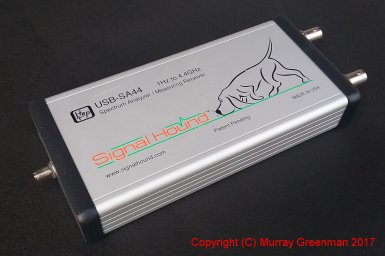
The Signal Hound USB-SA44 spectrum analyser
Digitech AR-1733 FM/MW/SW/LW/AIR receiver (2012)
This small unit is a true short wave receiver, as it operates 2.3 to 26.1 MHz AM, as well as 153 - 279 and 522 - 1620 kHz AM, and 88 - 108 MHz FM.
It also operates 118 to 137 MHz AM (the Air band). The receiver will operate off two AA cells or two AA NiCd cells, which it will charge from 5V
using a built-in charging function. There is a built-in telescopic whip antenna, internal ferrite rod for LW and AM,
but no external antenna socket. There is no BFO or SSB reception. Sensitivity is good, and the choices of bandwidth provided are ideal.
The receiver is touted as a DSP radio, and has some DSP-related functions. There are wide and narrow filters in AM modes,
and squelch on the Air band. There is a stereo decoder in FM mode. It uses digital demodulators and filters and digitally controlled volume.
The synthesizer is very smart, and will step in 9 kHz or 10 kHz steps to suit the AM band in the user's country. The tuning control has two speeds.
Slow step sizes are 1 kHz (AM) and 10 kHz (FM), while fast steps are 3 kHz (LW), 5 kHz (SW and Air), 9 kHz (AM) and 100 kHz (FM). There are 500
memories, arranged in 10 pages. The memories are a bit complicated to use, but in all other respects this is an impressive radio, and fun to use.
The receiver has up/down buttons in addition to the tuning knob, and will accept direct entry of frequency or memory number.
Battery life is very good. The display is back-lit and easily read. The clock is displayed while the receiver is off. The dimensions
are 125 x 75 x 50 mm, and it weighs 232g. It runs forever on a pair of AA cells.
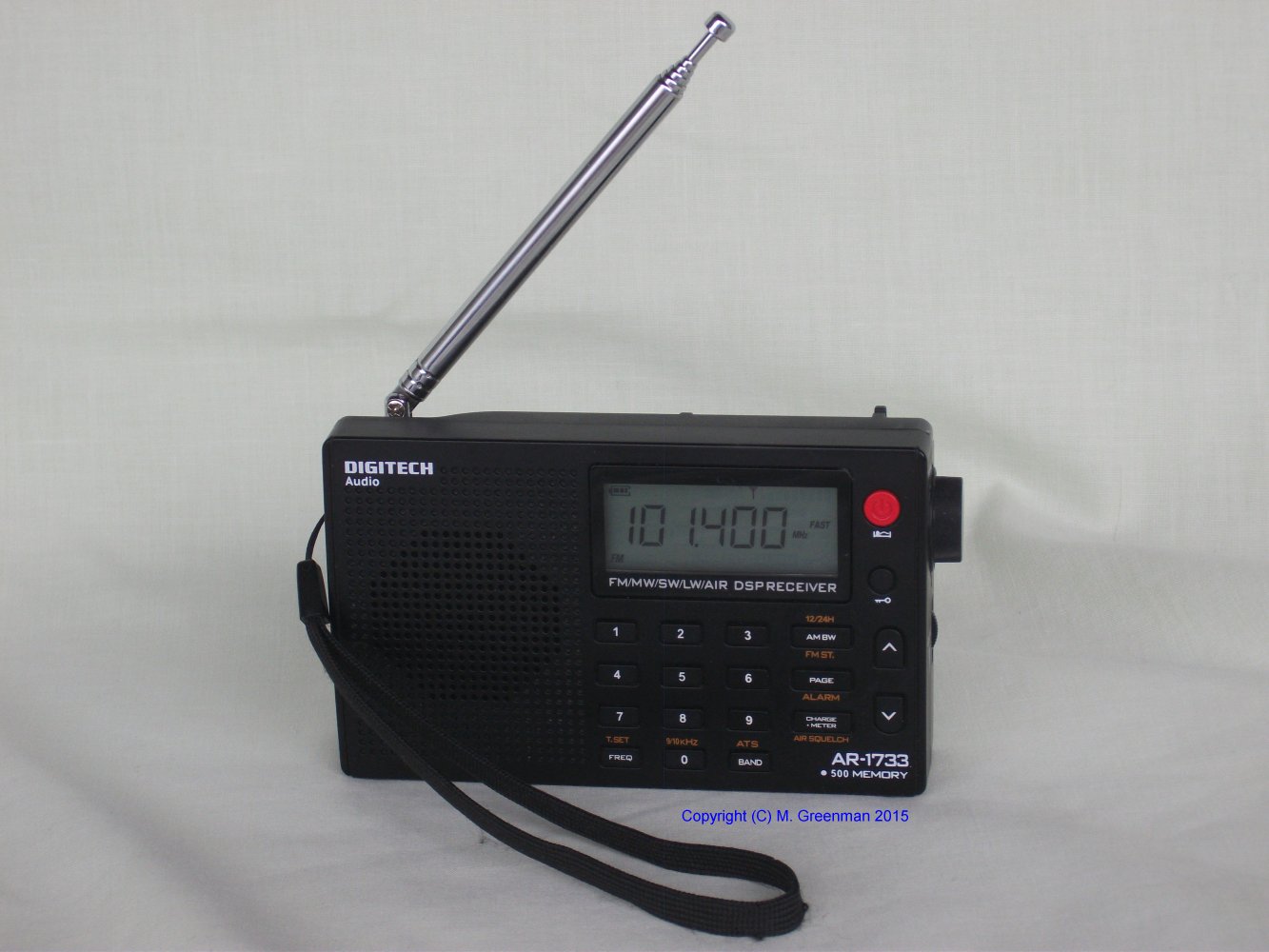
The Digitech AR-1733 receiver
GMYLE (Fulljoin) PPM001 FM/DAB receiver (2013)
This little unit isn't a communications receiver as such, but it does represent a step into new technology. It receives VHF FM
broadcasting and Digital Audio Broadcasts (DAB), so is my first digital receiver. The sensitivity in DAB mode isn't ideal, which
is probably a reflection on the technology, the distance from and the low power of the local DAB stations, rather than any shortcoming of the receiver.
It receives both DAB and DAB+. The former seems to have fewer dropouts, and the latter dropouts with annoying loud buzzing. The audio quality
of the DAB mode is subjectively better, absolutely no discernable noise, amazing presence and clarity. Audio quality is nothing short of stunning.
I know almost nothing of the technical details of the receiver. It is ETSI 300 401 DAB compliant, and receives 175 to 240 MHz DAB. In
FM mode it receives 88 - 108 MHz FM and has RDS functionality as well. It has a built in 700mAH LiPo battery which charges from 5V,
with very good operating life (7 hours operating, and a very long shelf life). The unit
has 30 station presets each for FM and DAB. There is no loudspeaker capability, just headphones, which double as the antenna. There is a socket
at the bottom for a Micro SD card, and it will record to and play from the SD card.
The receiver is simple to use, and has a good 128 x 64 FSTN display with backlighting. The only annoying thing is that it is very
easy to bump the controls, especially the on/off switch, while the receiver is in your pocket. The addition of an AM mode would have
improved utility, and would serve to illustrate how much better DAB reception can be! The receiver is only 94 x 54 x 14 mm and weighs just 64g.
It easily fits in your pocket. The battery is internal, LiPO technology, and is charged via USB.

The GMYLE PPM001 DAB receiver
RTL2832 R820T TV stick with direct sampling (2013)
These little devices were designed to provide low cost (US$12) DVB-T (Digital Terrestrial TV reception), DAB and FM reception,
but smart guys have reverse-engineered the
devices to provide reception of other modes as well - NBFM, AM, SSB and CW to name just a few of the possible modes. These units are
powered by USB, and transfer their data to a computer at high speed for further processing. They are of similar size to the usual memory stick.
There are two main chips within the device, a wideband tuner and a baseband chip (high speed 8-bit digitizer). The device used here has an R820T tuner chip and an RTL2832 baseband chip. It is compatible with both SDR# and HDSDR software,
plus many more packages for Windows, Linux or OSX.
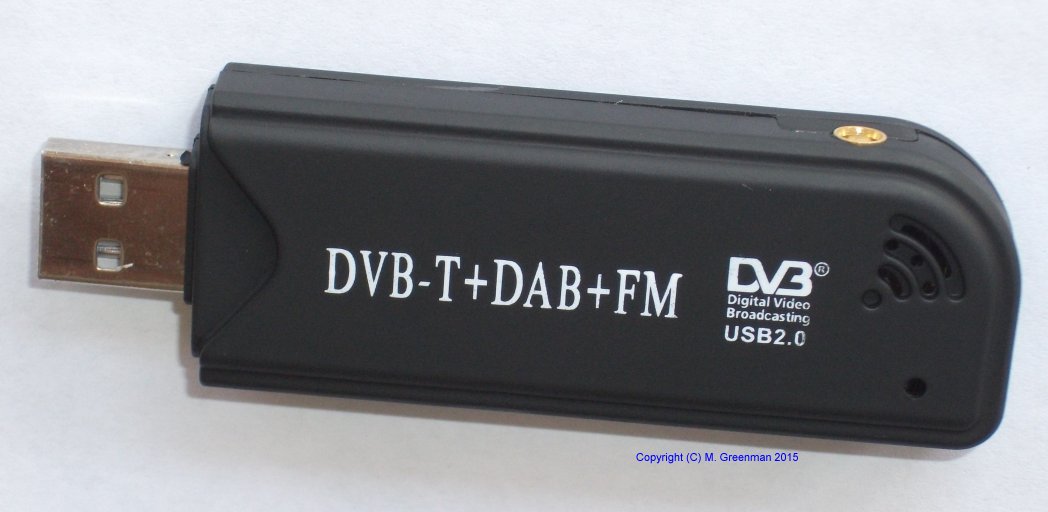
The R820T TV stick
I have modified this device to provide direct sampling for MF and HF reception, by fitting a tiny toroidal transformer inside the stick. This trick bypasses the R820T tuner and applies the antenna directly to the baseband chip via the unused Q+ and Q- inputs. (The R820T chip is
connected only to the
I+ and I- inputs). So by selecting the baseband chip mode in the software, I can use the stick and HDSDR for 100 kHz to 30 MHz, and with
SDR# for 24 to 1766 MHz.
While quite different to a conventional receiver, performance is remarkable. On MF and HF (where the tuner's low-noise preamp is not available)
sensitivity is modest, but quite adequate with an active antenna or on naturally noisy HF bands. The receiver would benefit from a preselector,
which would lower the noise floor on this simple 8-bit direct digitizer. A bandwidth of 1 MHz or more can be seen on the receiver panoramic display.
In this mode (first picture), the stick with HDSDR operates AM, AM Sync, FM, SSB, CW and receives wideband modes such as DRM. Using external software, the unit can
also be used for SSTV, DRM and other digital mode reception. Filters can be set to any required bandwidth. Stability and frequency accuracy
are impressive, giving much better results than using an up-converter.
In VHF mode (second picture), using the SDR# software, NBFM, wideband FM and AM operation are possible. Software includes squelch, memories and scanning features.
Here the tuner chip is used, and sensitivity is impressive. I've used this receiver for weather satellite reception.
Stability and frequency accuracy are quite adequate.
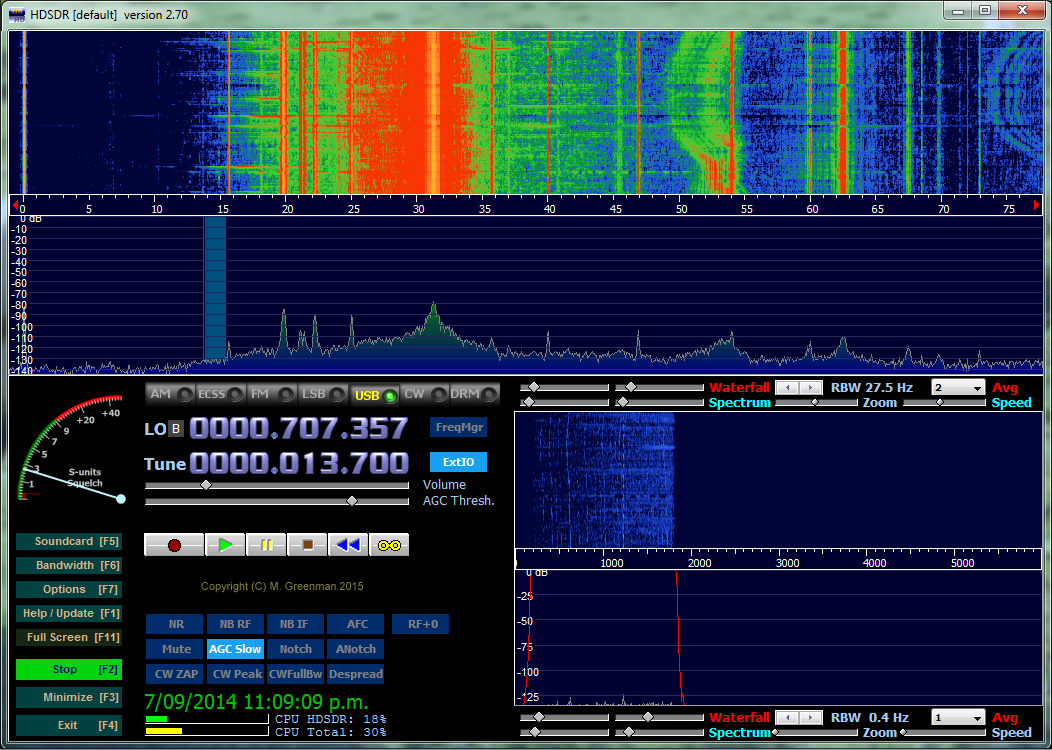
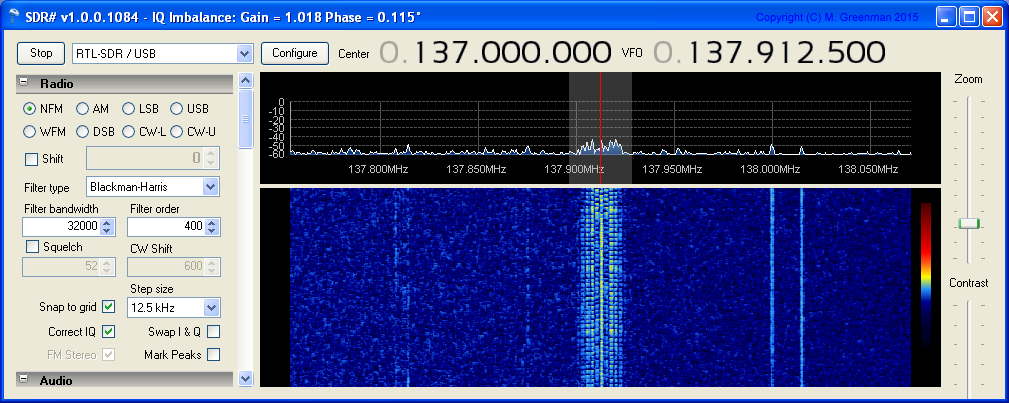
The R820T TV dongle (direct sampling mode) receiving on 13.7 kHz with HDSDR (left), and the R820T TV dongle (in tuner mode) receiving a weather satellite on 137.9 MHz with SDR# (right).
Afedri SDR-Net (2013)
This unit is a purpose-built 12-bit Software Defined Radio. It operates from 100 kHz to 30 MHz using 80M samples/sec direct sampling with
digital down conversion. It can process a bandwidth of up to 1.85 MHz when communicating via a network, although I've had no success
operating it in this mode. Output in USB mode has a bandwidth of up to 230 kHz. It can be powered via USB, although is best
with a separate supply, as the current is rather high for the usual USB port (7.5V at 400mA). The unit is small - 120 x 78 x 27 mm. It is housed in an
extruded Aluminium box with Aluminium end plates.
The Afedri SDR-Net can be used with standard SDR software such as HDSDR, and comes with a cross-platform control program which acts as the driver DLL. Using HDSDR, performance
is quite good, but after using the cheap ($12) RTLSDR dongle with more than 1 MHz bandwidth, it is hard to justify the small benefits of this
unit against the higher cost (more than 10 times). The unit has much improved noise floor if an external preselector is used.
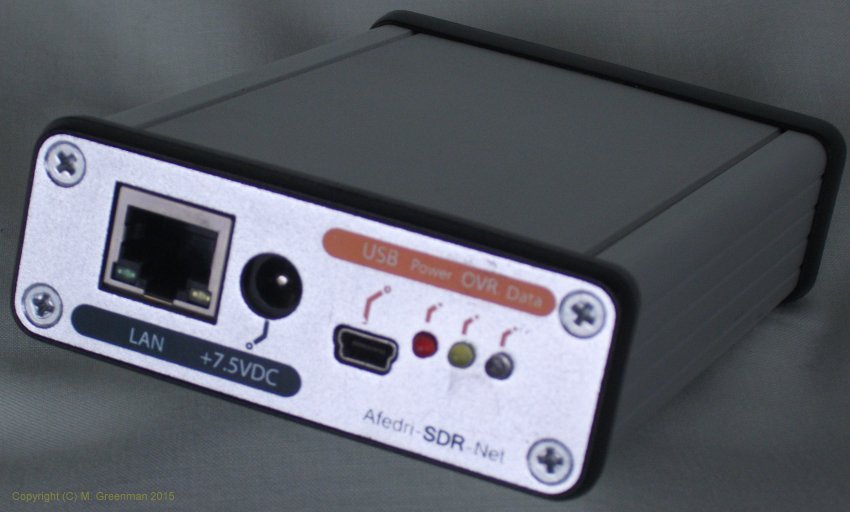
The Afedri SDR-Net unit
RTL2832 R820T TV stick V3 (2016)
Functionally similar to the TV stick receiver previously described, the so-called 'V3' TV stick has quite a few advantages.
Although it uses the same chips and provides 8-bit reception,
the 'V3' has been purpose-designed to provide the direct sampling option. It also has a robust metal case, improved heat management, and a
TCXO frequency reference for much improved frequency stability. The V3 performance is better at low frequencies than my home-adapted
version - it performs well down to 300 kHz and adequately down to 10 kHz. It will hear the Russian 'Alpha' station at 11 kHz.

The V3 TV stick
As you see, the the V3 has an SMA antenna connector, which is used in both the normal VHF/UHF mode and in LF/MF/HF direct sampling mode.
In the example below, the V3 is operating on a Linux Mint platform, using Gqrx software.
Note that is is receiving on the AM broadcast band in direct sampling mode. Switching between modes with this software is cumbersome,
but not difficult.
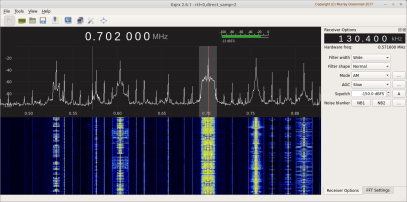
The V3 operating with Gqrx on 702 kHz
SDRPlay RSP1 (2016) and RSP2 (2017)
These two receivers are purpose built high performance 12-bit SDR devices. The RSP1 has a single antenna port, and a plastic box,
while the RSP2 (pictures below) has three antenna ports, which are software selectable, and a choice of metal or screened plastic box.
The RSP2 also has an 0.5ppm TCXO reference. I have the metal box version (the 'Pro' option), which also has connectors for reference
clock input and output (this allows multiple receivers to operate synchronously).
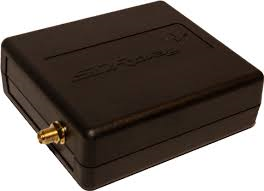
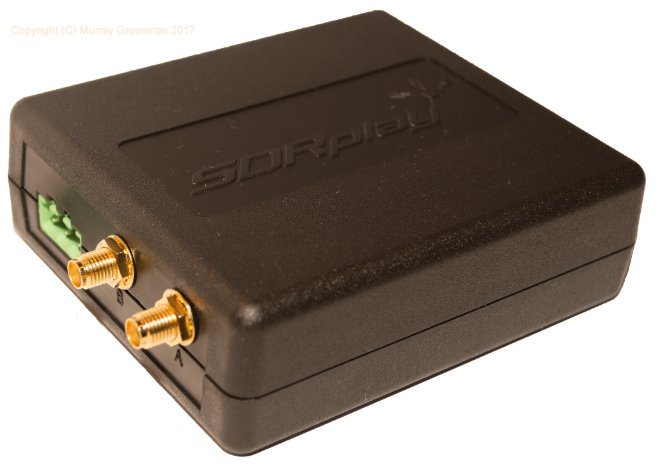
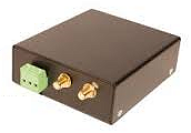
The RSP1 (left), RSP2 (centre), and RSP2 Pro receivers
The RSP1 operates from 10 kHz to 2 GHz in one range, while the RSP2 has continuous coverage from 1 kHz to 2 GHz. The RSP2 balanced LF input
is high impedance and operates from 1 kHz to 30 MHz, while the A and B (SMA coaxial) 50 Ohm inputs operate from 1.5 MHz to 2 GHz.
Both receivers have up to 10 MHz IF bandwidth, assuming the USB link and computer are fast enough, and with appropriate software
can be used to receive multiple stations (even in different modes) within a 10 MHz range at the same time.
The RSP2 has improved RF band-pass filters, improved RF gain management, and AM and FM band notch filters, which reduce intermodulation
from very strong broadcast stations. The ability to switch antennae is extremely useful. The RSP2 is a better receiver than any of the
conventional receivers I have, is more convenient and flexible to use, and of course was a lot cheaper than any conventional alternative.
My preferred software for these receivers is SDR Console, which currently supports the RSP2 in a beta version. SDRUno fully
supports both devices. Both programs are free. The RSP1 also works with SDR# and HDSDR, and on an Android platform, with SDRTouch.
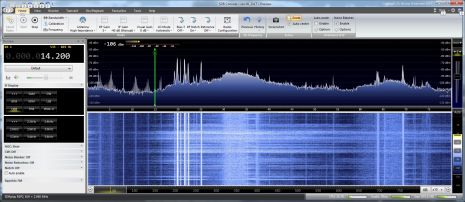
The RSP2 operating with SDR Console V3 beta, operating on 14.2 kHz,
and receiving a Russian 'Alpha' station during the day using the High Impedance antenna input
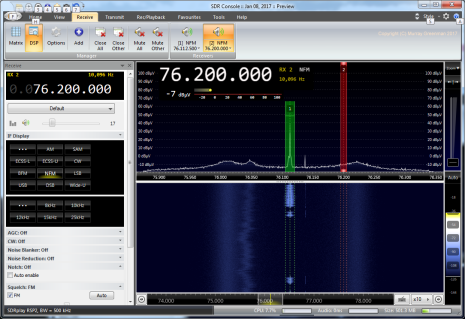
The RSP1 operating dual receive (NBFM) with SDR Console V3 beta,
on 76.2 MHz and 76.1125 MHz at the same time
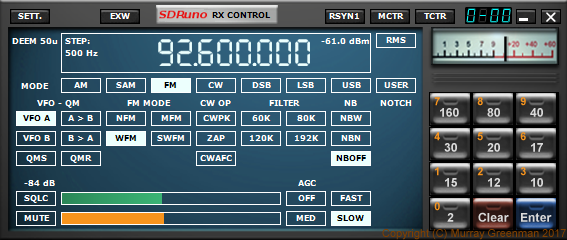
The RSP2 operating on 92.6 MHz (FM broadcast, WBFM) with SDRUno software.
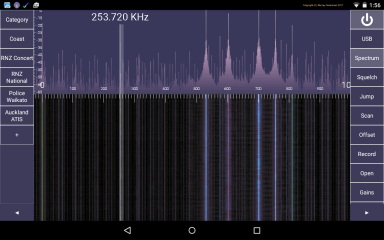
The RSP2 operating on 253.72 kHz in USB mode, (receiving an NDB)
on a Samsung Tab A (Android device) with SDRTouch.
SDR Console has superb graphics and is very versatile. While SDRUno looks simpler, and more like a conventional receiver,
it does include separate windows for waterfall and spectrum displays.
August MB400 DAB Receiver (2016)
This smart looking radio is not your average old-style mantel radio. It supports Bluetooth reception (including NFC
connection), will play from a USB stick or MicroSD card MP3 and WAV files, and shows track information on the display.
Unusually for a portable radio, there's no handle, and it is not small
nor light, but it has decent-sized stereo speakers, plenty of audio, and really good sound.
The MB400 is very well engineered, and quite robust. It operates from
four C-sized dry cells or an AC adaptor, not supplied. Oh yes, and it's also a radio receiver, operating from 87.5 to 108 MHz FM stereo, as well as
174 to 240 MHz DAB and DAB+ (Digital Audio Broadcast). There is no AM mode. The receiver includes RDS station information
in FM and DAB, and uses a back-lit LCD display.
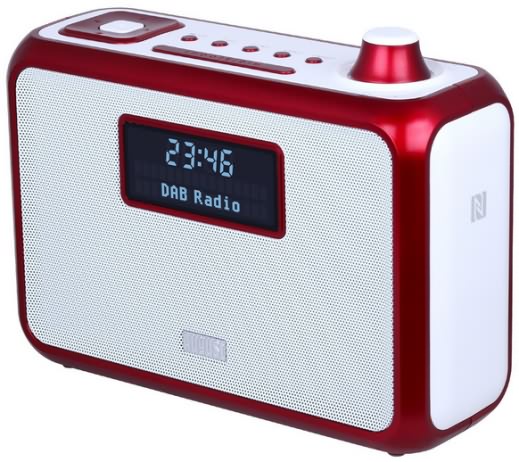
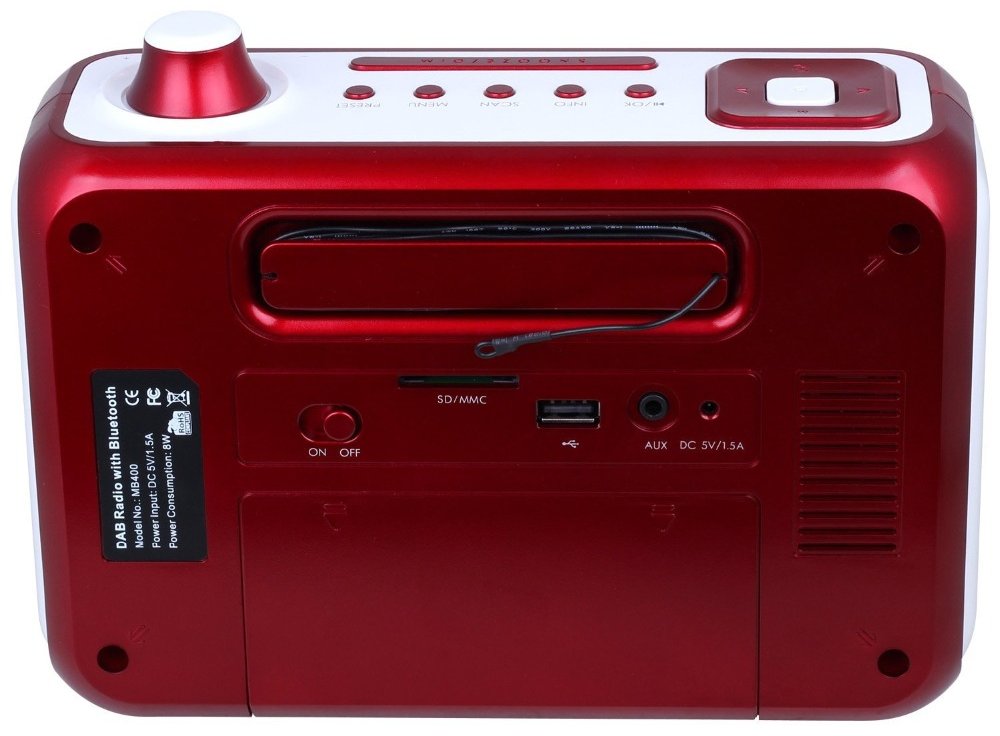
The August MB400 mantel radio front (left)
and rear (right)
The receiver performs superbly, with good clarity, good bass, and pleasantly low noise (given enough signal).
In DAB mode there is simply no noise, and excellent dynamic range.
The DAB fuction is able to set the clock, and it can be set manually if DAB isn't available. The controls
are fairly easy to understand and use.
One unusual aspect of the MB400 is
that the only antenna provided is a random wire, which is wound up in a recess at the back (see rear view). I guess it is intended as a mantel radio,
but in this day and age a telecopic whip or an antenna connector would be preferable. Unless signals are very strong, it does not receive anything with the antenna wound up, so it's
not that practical as a portable receiver, but still great as an MP3 or Bluetooth player. When I've summoned up enough courage, I think I'll add an antenna connector on the back.
Rolton T50 FM/MW/SW Receiver (2017)
Manufactured by ShenZen Mando Technology Co. Ltd, this cool little radio is a pocket-sized powerhouse. I use that term
intentionally, as it runs from a huge 1500 mAH Li Ion cell, which seems to last forever! It is charged using a USB cable.
The radio covers FM 64 to 108 MHz in two bands (mono only), MF 520 to 1710 kHz (both 9 kHz and 10 kHz spacing offered), and eight
short wave bands from 5.6 MHz to 22 MHz. It also features a decent LED torch and a uSD card slot. Even better, you can
transfer music to and from the uSD card via the USB connection!
There is a ferrite rod antenna for MF and a fairly small telescopic whip for HF and VHF. Despite the small antenna, performance
is adequate. The case is ABS, but is lacquered to give a bright and shiny appearance. There's 1W of audio available, and there's a passive radiator which helps improve bass response from such a little box (132 x 30 x 66 mm). Audio clarity is excellent.
In recent years just about every radio has used an LCD display to extend battery life, but this little guy has power to burn, and features a bright red LED display, easy to see except in direct sunlight, and really useful at night.
The radio has direct frequency entry on all bands, plus up/down buttons. Frequency entry within band is easy enough, but
the radio is split into 12 bands, which makes life complicated, as you have to check the band range in the manual
in order to get to where you want to go, as if the frequency is not in the current band, the command will be ignored.
Fortunately the manual is in reasonable English, and the same size as the radio, so not difficult to carry around.
The radio plays MP3 and WAV files really well. However, there is no track display other than a number, so finding
a particular track is something of a challenge. There are basic search, scan and pause functions, but no random play. Audio
quality from file is very good.
There is a clock function, and the radio features auto-scan, although with no information displayed about the stored
memories, finding a particular radio station from memory is again pot luck. On all bands, reception is reasonable
if the signal is strong, but weaker stations are masked by buzz noises and whistles generated within the radio.
In terms of value for money, compare this radio (it cost me US$17) with the Sony ICF-2001, which in 1980 cost about US$350,
or about six weeks' wages.
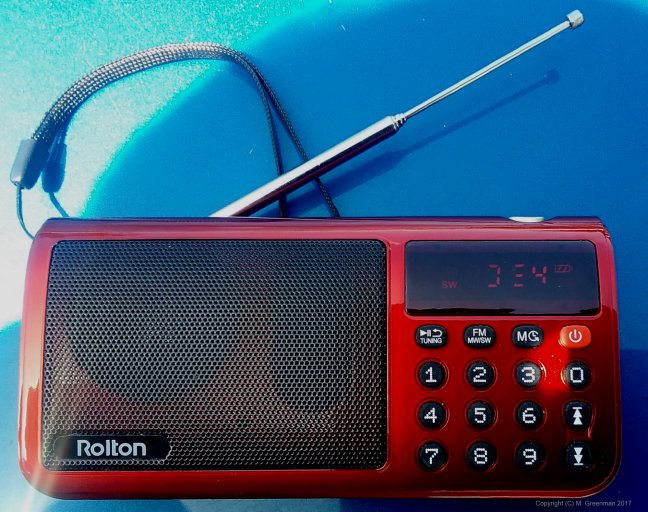
The Rolton T50 pocket rocket
Introduction
1920s - 1950s
1960s
1970s
1980s
1990 - today
Copyright � Murray Greenman 1997-2019.
All rights reserved. Contact the author before using any of this material.






















